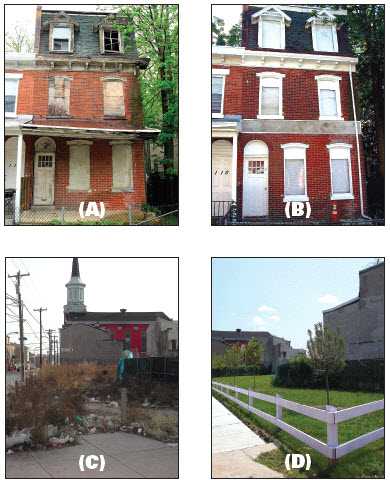Success Stories

Since CDC began funding Injury Control Research Centers (ICRCs) in 1987, the ICRCs have advanced the injury and violence prevention field. The following success stories detail the important work ICRC’s do to study injuries and violence and to put their research findings into action to save and protect lives.
Research Impact
- Preventing Violence through Blight Remediation (Penn Injury Science Center)
- Addressing Teen Dating Violence Before It Begins (University of North Carolina Injury Prevention Research Center)
- Strengthening Interdisciplinary Collaboration with Expert Research Teams (University of Iowa Prevention Research Center)
- Implementing a Violence Prevention Program for Juvenile Offenders (Mount Sinai Injury Control Research Center)
Training Impact
- Developing the Next Generation of Researchers and Practitioners (Johns Hopkins Center for Injury Research and Policy)
- Reaching Broad Audiences with Cutting-Edge Science (University of Michigan Injury Center)
- Advancing Public Health Approaches to Suicide Prevention (University of Rochester Center for the Study and Prevention of Suicide)
Outreach Impact
- Changing Safety Standards for Laundry Detergent Packets (Nationwide Children’s Hospital Center for Injury Research and Policy)
- Educating Stakeholders about the Opioid Overdose Epidemic and Naloxone Programs (West Virginia University Injury Control Research Center)
- Preventing Motor Vehicle Injuries (Center for Injury Epidemiology and Prevention at Columbia University)
Research Impact

Before-after remediations: abandoned building (a, b) and vacant lot (c, d).
Preventing Violence through Blight Remediation (Penn Injury Science Center)
The recent economic downturn and job losses have left many U.S. cities with blighted neighborhoods full of abandoned lots and buildings. The University of Pennsylvania Injury Science Center (Penn Injury Science Center) conducted groundbreaking experimental research based on principles from Crime Prevention through Environmental Design. Penn Injury Science Center studied the impact of low-cost repairs to abandoned buildings and vacant lot greening on residents’ health, safety, and quality of life. For the past decade, they partnered with Philadelphia and a half dozen other cities around the United States to study what happened when these cities used inexpensive, readily implemented interventions to clean, repair, and green nearly 10,000 abandoned buildings and vacant lots. These blight remediation programs are straightforward and quickly implemented—graffiti and trash removal, simple installation of new windows and doors, planting grass and trees, and installing basic wooden fences—yet immediately evident to grateful city residents. These interventions are easy to scale and adapt to many different urban environments. Penn Injury Science Center completed large, randomized controlled trials of these same abandoned building and vacant lot remediation strategies in other communities, even beyond Philadelphia, with additional federal and private funds.
The impact of these simple improvements is remarkable. City-wide, areas around remediated abandoned buildings had a 39 percent drop in gun assaults, 19 percent drop in other assaults, and a 16 percent drop in nuisance crimes. Vacant lot greening also led to significant, long-term reductions in gun violence (8 percent drop) and vandalism, and residents’ reporting less stress and more exercise. Every dollar invested in these remediation programs returned anywhere from $5–$333 in violence related-costs that were averted. Word of the projects’ successes has also spread, leading the Penn Injury Science Center to now link with partners in Louisiana, Michigan, New Jersey, Ohio, Virginia, and other states in remediating hundreds of additional blighted spaces in new cities and evaluating the impact.
To learn more:
Penn Urban Health Lab
Addressing Teen Dating Violence Before It Begins (University of North Carolina Injury Prevention Research Center)
In 2015, one of every 10 U.S. high school students reported being sexually or physically victimized during a date in the last year. To address this issue, researchers at the University of North Carolina Injury Prevention Research Center (UNC IPRC) designed Safe Dates, a teen dating violence prevention program for middle and high school students. Safe Dates is highly engaging and interactive and helps teens recognize the difference between caring, supportive relationships and controlling, manipulative, or abusive dating relationships.

UNC IPRC researchers tested the program in 14 public schools. The results showed a significant reduction in both perpetration of dating violence and victimization. Adolescents participating in the program also reported less acceptance of dating violence, stronger communication and anger management skills, less gender stereotyping, and greater awareness of community services for dating abuse. Four years after the program, adolescent participants reported far less dating violence victimization and perpetration (56 percent to 92 percent less) than other students.
Additional research showed that Safe Dates also reduced peer victimization and weapon carrying behavior among youth who participated one year after receiving the intervention.
As a result of the program’s proven success, Safe Dates has become one of the most extensively used and endorsed teen dating violence programs. It is designated as a Model Program by the Substance Abuse and Mental Health Services Administration and was selected for the National Registry of Evidence-based Programs and Practices (NREPP), a prestigious national registry that promotes the adoption of scientifically proven behavioral health interventions. This highly rated model has been adopted in more than 20,000 locations and has reached more than 1.68 million youth in the United States, Canada, Chile, Greece, Iceland, Ireland, Japan, the Netherlands, Switzerland, Taiwan, Thailand, and the United Kingdom. In addition, Safe Dates has been added to CDC’s 2016 STOP SV: Technical Package to Prevent Sexual Violence, which helps communities and states design effective prevention activities and represents a select group of strategies with the greatest potential to reduce sexual violence and its consequences.
To learn more:
University of North Carolina Injury Prevention Research Center

Strengthening Interdisciplinary Collaboration with Expert Research Teams (University of Iowa Prevention Research Center)
The University of Iowa Injury Prevention Research Center (UI IPRC) brings together experts in many different fields to discover ways to prevent injuries and violence in rural communities. UI IPRC partnered with Blank Children’s Hospital and the Public Policy Center to evaluate an intervention for parents to improve communication with and supervision of their teens who were learning to drive—particularly in rural settings. Participating teens reported a 21 percent decrease in risky driving. The program is now being translated into workplace wellness programs of three Iowa companies and has garnered $3.5 million in additional funding.
In addition, road traffic safety team efforts have led to safer roadways locally, nationally, and internationally. The UI IPRC conducts the Iowa Child Passenger Safety Seat Survey, funded through the Governor’s Highway Traffic Safety Bureau, and has leveraged this design to conduct child passenger occupant surveys in other communities internationally, some of which have led to hospital-based programs to increase child restraint use. This example highlights how the wide-reaching impact that ICRC research conducted in local settings can have an impact nationally and internationally.
To learn more:
University of Iowa Prevention Research Center
Implementing a Violence Prevention Program for Juvenile Offenders (Mount Sinai Injury Control Research Center)
The Mount Sinai Injury Control Research Center at the Icahn School of Medicine is working with the Texas Juvenile Justice Department to reduce criminal offenses and violent crimes among youth offenders with and without traumatic brain injury (TBI). They adapted their evidence-based cognitive rehabilitation intervention originally developed for adults with TBI to a youth population. The Youth Short-term Executive Plus (Y-STEP) intervention, which focuses on improving cognitive processing and emotional self-regulation, is being implemented and evaluated in the El Paso Juvenile Justice Center. To date, interim analysis indicates that youth participating in Y-STEP had a 44% reduction in recidivism (person’s relapse into criminal behavior). Recidivism is measured by criminal acts that resulted in re-arrest, reconviction or return to prison with or without a new sentence during a three-year period following the prisoner’s release.
To learn more:
Mount Sinai Injury Control Research Center
Training Impact
Developing the Next Generation of Researchers and Practitioners (Johns Hopkins Center for Injury Research and Policy)

Johns Hopkins Center for Injury Research and Policy (CIRP) plays a critical role training and developing the next generation of researchers and public health professionals. The Center has graduated thousands of students at all levels of training, from undergraduate to post-doctoral since its creation in 1987. Faculty affiliated with the center offer the most graduate courses in injury and violence prevention anywhere in the world. These courses, now number 25, and cover topics such as transportation safety, youth violence, substance abuse, and trauma care, and the multiple disciplines used in injury research and practice such as epidemiology, law and policy, behavioral science, and communication. These courses reach 300–400 undergraduate, masters, and doctoral students annually. As a result, the center contributes to the supply of qualified practitioners and researchers dedicated to ensuring that injury and violence prevention research continues to flourish and that it tackles new problems as they emerge.
Johns Hopkins CIRP-mentored doctoral graduates (at least 3–4 per year) secure faculty positions at prestigious institutions throughout the country, most recently in Colorado, Massachusetts, Maryland, and Illinois. They continue to conduct research, publish papers in highly regarded journals, and present their work at key national meetings. Doctoral graduates have also secured leadership positions in health care and public health settings. For instance, in the last 5 years, one of the center’s graduates has gone on to become a trauma research manager at a large Level 1 trauma center; another serves as Director of Health Research and Innovation for a global healthcare design firm. And a third is the Social Science Research Analyst for the Office of Planning, Research and Evaluation in the Department of Health and Human Services (DHHS) Administration for Children and Families.
Finally, the Johns Hopkins ICRC has provided doctoral and post-doctoral training to at least seven individuals who have gone on to become directors of other ICRCs, illustrating the important role centers can have in developing and grooming the next cadre of injury prevention scholars and leaders.
The core of Hopkins’ training and professional development is its award-winning Summer Institute (SI) that has trained nearly 800 participants. This premier training program was honored in 2013 with the Ellen P. Schmidt Award from Safe States Alliance, the leading professional organization for state-based injury and violence prevention practitioners. SI alumni form a strong, active, and growing network for sharing knowledge and applying skills in their communities. SI participants and graduates hold leadership positions in federal agencies, such as DHHS, state health department violence and injury prevention programs, and in local agencies, such as emergency medical services and trauma centers.
To learn more:
Johns Hopkins Center for Injury Research and Policy
Reaching Broad Audiences with Cutting-Edge Science (University of Michigan Injury Center)
The University of Michigan Injury Center (UMIC) sponsors a series of day-long summits to teach diverse audiences about significant topics in injury and violence prevention, most recently sport concussions and prescription drug overdose. The Sport Concussion Summit featured invited experts who explored the latest science on sports concussions and relevant issues beyond the playing field. The summit focused on researchers, clinicians, practitioners, policy makers, and members of the media—but also welcomed athletic trainers, coaches, athletes, students, and parents.
To further increase awareness, UMIC produced a 10-minute video called “Concussion 101,” featuring interviews with summit speakers, which has had more than 1,200 views to-date on their YouTube channel. The video has been lauded by the Brain Injury Association (BIA) of Michigan and the National Collegiate Athletic Association (NCAA) and has been posted prominently on both organizations’ websites. The BIA is also showing it at local movie theaters. “Our concussion summit was a great example of work only a center can do that reaches beyond a single study,” noted UMIC’s Director, Dr. Rebecca Cunningham. “It had wide appeal, using innovative strategies to reach professional, lay, and public audiences with the latest science.”
To learn more:
University of Michigan Injury Center
Advancing Public Health Approaches to Suicide Prevention (University of Rochester Center for the Study and Prevention of Suicide)
The Injury Control Research Center for Suicide Prevention (ICRC-S) at the University of Rochester Medical Center conducts a bi-annual training to promote the study of public health approaches to suicide prevention. The 4-day Research Training Institute (RTI) equips injury and violence prevention professionals and researchers across the nation with information on suicide prevention science and research methods. The RTI also fosters collaborative links between the injury and violence prevention and suicide research communities to facilitate the sharing of perspectives, knowledge and skills. Researchers and practitioners apply as teams, proposing collaborative suicide prevention research projects that they develop during the RTI and through an extended period of mentoring support that follows. Examples of RTI collaborative research projects include the development of community-based suicide prevention programs, investigations into the reorganization of emergency room services, and explorations of how state agencies and researchers can more effectively work together to prevent suicide.
To learn more:
University of Rochester Center for the Study and Prevention of Suicide
Outreach Impact
Changing Safety Standards for Laundry Detergent Packets (Nationwide Children’s Hospital Center for Injury Research and Policy)

Laundry detergent packets, first sold in the United States in 2012, have become widely used in homes across the country. Packets tend to be round, colorful, and closely resemble candy—particularly to young children. As packet popularity increased, so have child poisonings associated with this product. Concern over this issue led the Center for Injury Research and Policy (CIRP) and the Central Ohio Poison Center—both based at Nationwide Children’s Hospital—to conduct a study in 2014 to quantify the risks. The research showed that from 2012 through 2013, U.S. poison control centers received reports of more than 17,000 children under age 6 who swallowed, inhaled, or were exposed to the chemicals in laundry detergent packets—an average of one child every hour. Seven hundred and sixty nine children were hospitalized during that period and two children died. Other clinical effects included vomiting, coughing or choking, eye pain or irritation, and drowsiness.
CIRP conducted a follow-up study that compared the medical risks and outcomes of exposure to laundry detergent packets with other types of laundry and dish detergents. They found that the harmful effects of laundry packets were significantly higher.
Leadership from Nationwide Children’s Hospital’s ICRC and their partners shared these results with key legislative and policy audiences, and with parents and industry. Based on the data, legislation was introduced in February 2015 by members of the U.S. Congress to require the U.S. Consumer Product Safety Commission (CPSC) to set mandatory safety standards for liquid laundry detergent packets.
The bill, called the Detergent PACS (Poisoning and Child Safety) Act of 2015, also allows CPSC to adopt a voluntary safety standard by ASTM International, a standards development organization, or to create its own standard. Dr. Gary Smith, director of CIRP and senior author of the studies, provided input on the legislative language to “make sure that all packet- makers adopt safer packaging and labeling.” In 2015, ASTM International published a voluntary Standard Safety Specification for Liquid Laundry Packets to help reduce unintentional exposures to the contents of the packets, especially by children. After the first study, the Consumers Union recommended that laundry detergent packets not be used, which is only the second time in its history it has made such a strong statement.
As a result of this work, some manufacturers have changed the container of their laundry detergent packets from clear to opaque and have made them less easy to open for children. Other manufacturers began including safety warnings in their ads and on their packaging, advising that laundry detergent packets are a danger to children under 3 years old and need to be stored safely.
Representatives working on laundry detergent packet safety from Canada, Sweden, and New Zealand have requested data from CIRP regarding its studies for use in developing safety policy in their countries.
To learn more:
Nationwide Children’s Hospital Center for Injury Research and Policy
News article on CIRP’s laundry detergent packet study
Educating Stakeholders about the Opioid Overdose Epidemic and Naloxone Programs (West Virginia University Injury Control Research Center)
The West Virginia University Injury Control Research Center (WVU ICRC) is supporting the implementation of take-home naloxone programs in substance abuse treatment centers, among law enforcement agencies, and substance abuse treatment programs around the state. The WVU ICRC first conducted research that demonstrated the effectiveness of naloxone programs in rural areas. They used the findings to educate key stakeholders about the opioid overdose epidemic in WV and the effectiveness of take-home naloxone programs. WVU ICRC was instrumental in informing stakeholders who then use the information to reduce liability concerns that were central to the successful implementation of these programs. In collaboration with key partners, the WVU ICRC is training and equipping law enforcement agencies around the state to carry and administer take-home naloxone. There were at least 25 overdose reversals in the first 9 months after the program was implemented in 16 counties.
To learn more:
West Virginia University Injury Control Research Center
Preventing Motor Vehicle Injuries (Center for Injury Epidemiology and Prevention at Columbia University)

Ensuring the safety of children as they walk to and from school was formally recognized as a national priority in 2005, with federal funding of the Safe Routes to School (SRTS) program. Eight years earlier, New York City (NYC) implemented the first program in the United States, followed shortly by many other cities. Until recently, however, little was known about SRTS’s impact on pedestrian injuries. The Center for Injury Epidemiology and Prevention at Columbia University (CIEPAC) developed a well-designed evaluation that documented a 44 percent reduction in injuries among children walking to school. CIEPAC used these findings to generate media attention and to spark support among NYC officials for a citywide campaign on pedestrian and traffic safety. This research, training, and outreach has supported policy changes, including the enactment of a city-wide 25 mile-per-hour speed limit and adoption of NYC regulations for better pedestrian safety. Word of CIEPAC’s success has spread rapidly to cities throughout the nation, stimulating numerous efforts to make our roadways safe for pedestrians of all ages.
To learn more:
Center for Injury Epidemiology and Prevention at Columbia University
- Page last reviewed: February 1, 2017
- Page last updated: February 1, 2017
- Content source:
- Centers for Disease Control and Prevention, National Center for Injury Prevention and Control


 ShareCompartir
ShareCompartir